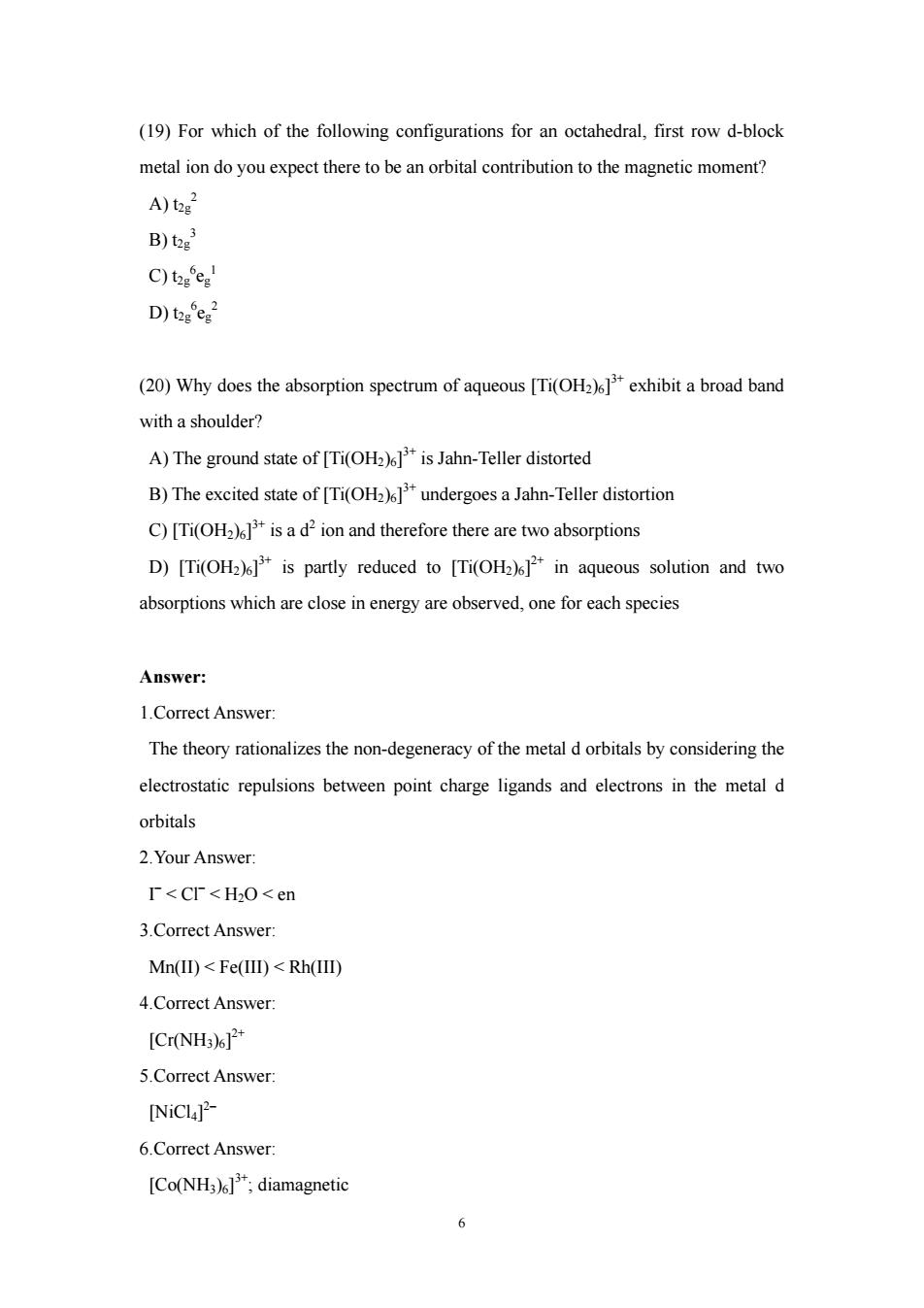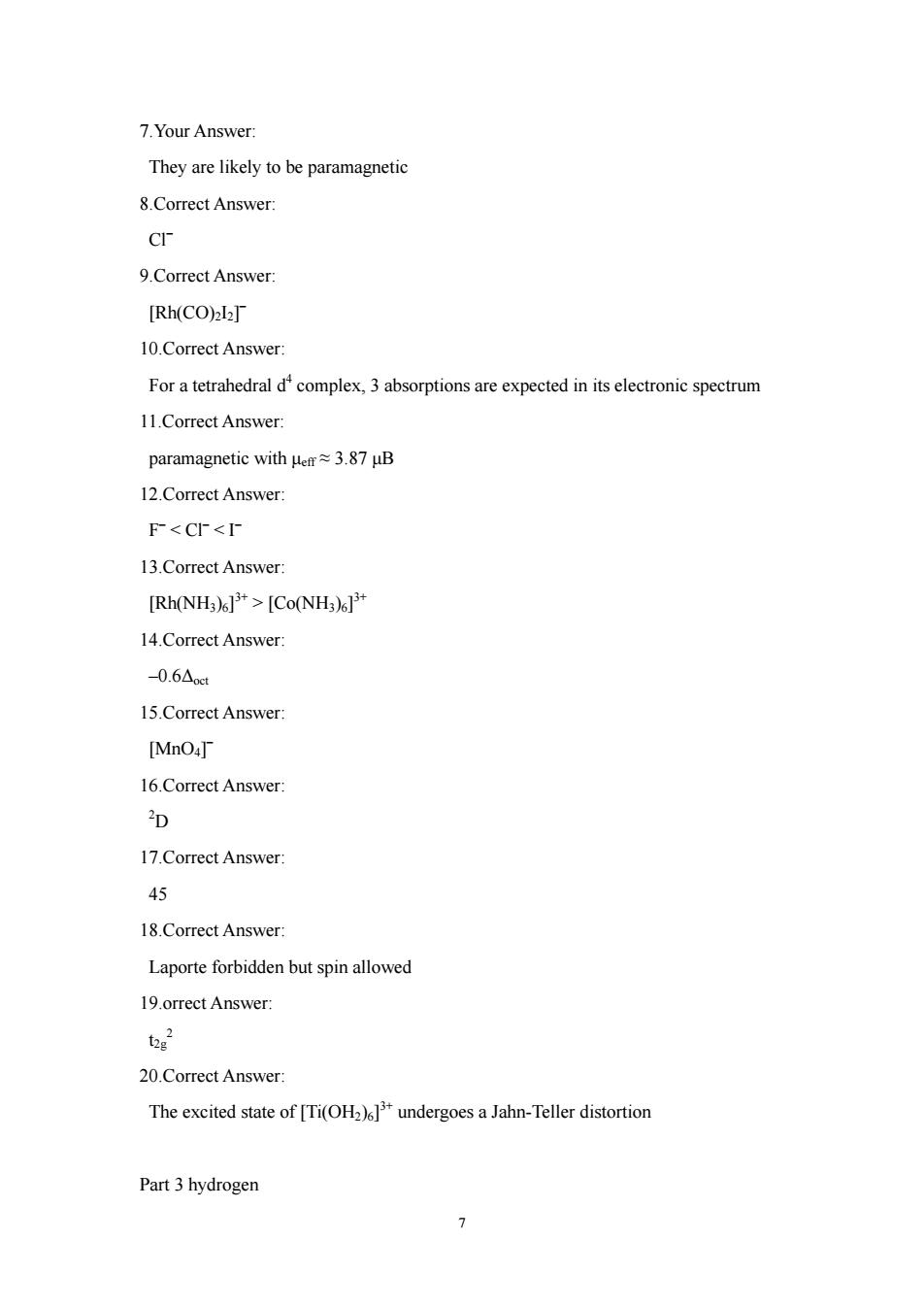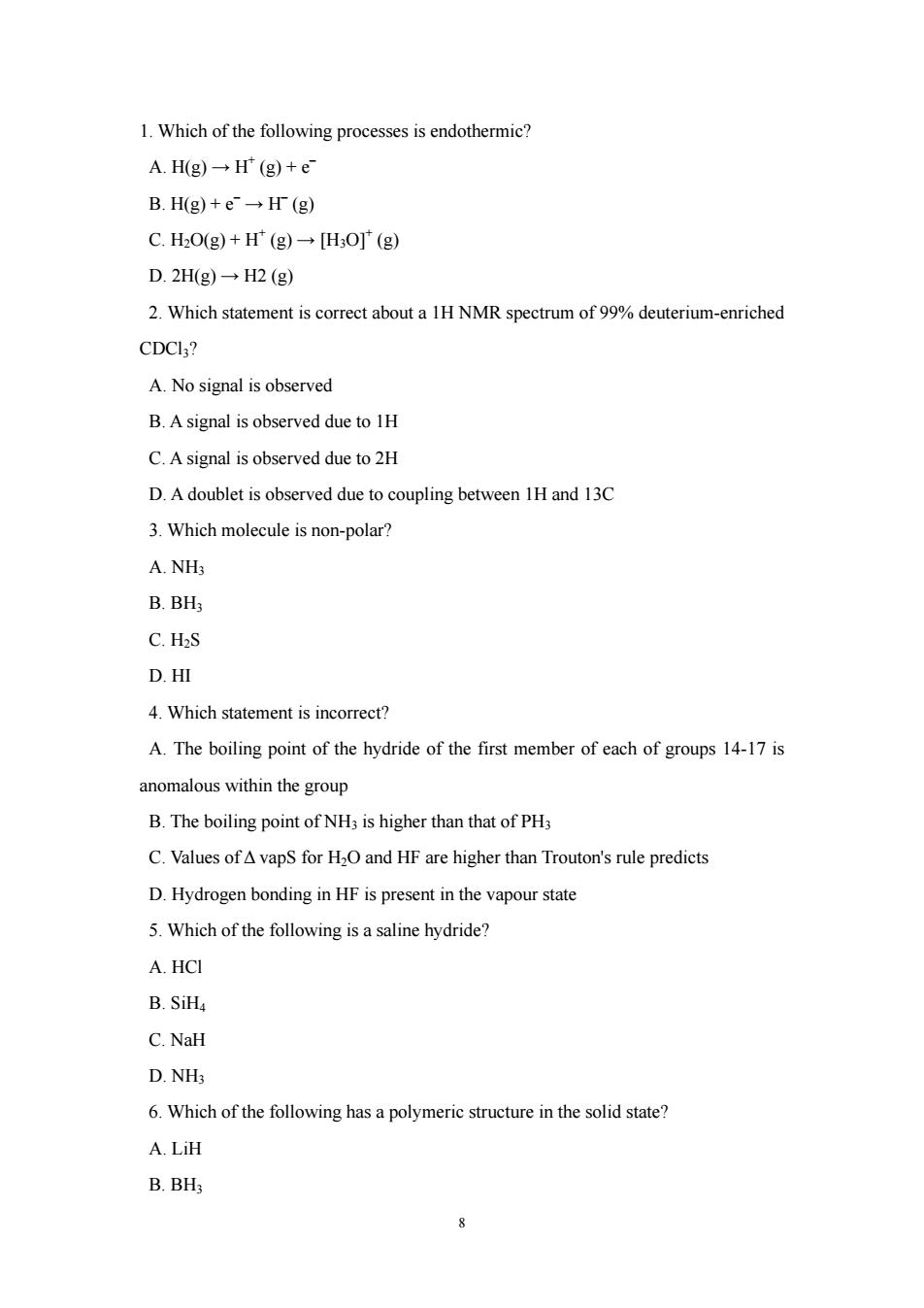
(19)For which of the following configurations for an octahedral,first row d-block metal ion do you expect there to be an orbital contribution to the magnetic moment? A)t2g2 B)t2g C)tzgeg D)tgeg2 (20)Why does the absorption spectrum of aqueous [Ti(OH2)6]exhibit a broad band with a shoulder? A)The ground state of [Ti(His Jahn-Teller distorted B)The excited state of [iH)undergoesa Jahn-Teller distortion C)i(Hisad2ion and therefore there are two absorptions D)[Ti(OH2)]is partly reduced to [Ti(H)in aqueous solution and two absorptions which are close in energy are observed,one for each species Answer: 1.Correct Answer The theory rationalizes the non-degeneracy of the metald orbitals by considering the electrostatic repulsions between point charge ligands and electrons in the metal d orbitals 2.Your Answer: r<Cr<H2O<en 3.Correct Answer: Mn(ID<Fe(II)<Rh(ID) 4.Correct Answer [Cr(NH3)6P 5.Correct Answer: [NiCl]2- 6.Correct Answer: [Co(NH)diamagnetic
(19) For which of the following configurations for an octahedral, first row d-block metal ion do you expect there to be an orbital contribution to the magnetic moment? A) t2g 2 B) t2g 3 C) t2g 6 eg 1 D) t2g 6 eg 2 (20) Why does the absorption spectrum of aqueous [Ti(OH2)6] 3+ exhibit a broad band with a shoulder? A) The ground state of [Ti(OH2)6] 3+ is Jahn-Teller distorted B) The excited state of [Ti(OH2)6] 3+ undergoes a Jahn-Teller distortion C) [Ti(OH2)6] 3+ is a d2 ion and therefore there are two absorptions D) [Ti(OH2)6] 3+ is partly reduced to [Ti(OH2)6] 2+ in aqueous solution and two absorptions which are close in energy are observed, one for each species Answer: 1.Correct Answer: The theory rationalizes the non-degeneracy of the metal d orbitals by considering the electrostatic repulsions between point charge ligands and electrons in the metal d orbitals 2.Your Answer: I– < Cl– < H2O < en 3.Correct Answer: Mn(II) < Fe(III) < Rh(III) 4.Correct Answer: [Cr(NH3)6] 2+ 5.Correct Answer: [NiCl4] 2– 6.Correct Answer: [Co(NH3)6] 3+; diamagnetic 6

7.Your Answer: They are likely to be paramagnetic 8.Correct Answer 9.Correct Answer: [Rh(CO)2I2 10.Correct Answer For a tetrahedraldcomplex,3 absorptions are expected in its electronic spectrum 11.Correct Answer: paramagnetic with e3.87 uB 12.Correct Answer F<Cr<I 13.Correct Answer: [Rh(NH3)6]>[Co(NH3)6] 14.Correct Answer: -0.6Ag 15.Correct Answer: [MnO4 16.Correct Answer: 20 17.Correct Answer: 5 18.Correct Answer: Laporte forbidden but spin allowed 19.orrect Answer: 20.Correct Answer: The excited state of [Ti(OH2)]undergoes a Jahn-Teller distortion Part 3 hydrogen 7
7.Your Answer: They are likely to be paramagnetic 8.Correct Answer: Cl– 9.Correct Answer: [Rh(CO)2I2] – 10.Correct Answer: For a tetrahedral d4 complex, 3 absorptions are expected in its electronic spectrum 11.Correct Answer: paramagnetic with μeff ≈ 3.87 μB 12.Correct Answer: F– < Cl– < I– 13.Correct Answer: [Rh(NH3)6] 3+ > [Co(NH3)6] 3+ 14.Correct Answer: –0.6Δoct 15.Correct Answer: [MnO4] – 16.Correct Answer: 2 D 17.Correct Answer: 45 18.Correct Answer: Laporte forbidden but spin allowed 19.orrect Answer: t2g 2 20.Correct Answer: The excited state of [Ti(OH2)6] 3+ undergoes a Jahn-Teller distortion Part 3 hydrogen 7

1.Which of the following processes is endothermic? A.H(g)→(g)+e B.H(g)+e→f(g) C.H0g)+(g)→H,O(g) D.2Hg)→H2(g) 2.Which statement is correct about a 1H NMR spectrum of 99%deuterium-enriched CDCI3? A.No signal is observed B.A signal is observed due to IH C.Asignal is observed due to 2H D.A doublet is observed due to coupling between IH and 13C 3.Which molecule is non-polar? A.NHs B.BH C.H2S D.HI 4.Which statement is incorrect? A.The boiling point of the hydride of the first member of each of groups 14-17 is anomalous within the group B.The boiling point of NH3 is higher than that of PH3 C.Values of AvapS for HO and HF are higher than Trouton's rule predicts D.Hydrogen bonding in HF is present in the vapour state 5.Which of the following is a saline hydride? A.HCI B.SiHa C.NaH D.NH; 6.Which of the following has a polymeric structure in the solid state? A.LiH B.BHs
1. Which of the following processes is endothermic? A. H(g) → H+ (g) + e– B. H(g) + e– → H– (g) C. H2O(g) + H+ (g) → [H3O]+ (g) D. 2H(g) → H2 (g) 2. Which statement is correct about a 1H NMR spectrum of 99% deuterium-enriched CDCl3? A. No signal is observed B. A signal is observed due to 1H C. A signal is observed due to 2H D. A doublet is observed due to coupling between 1H and 13C 3. Which molecule is non-polar? A. NH3 B. BH3 C. H2S D. HI 4. Which statement is incorrect? A. The boiling point of the hydride of the first member of each of groups 14-17 is anomalous within the group B. The boiling point of NH3 is higher than that of PH3 C. Values of Δ vapS for H2O and HF are higher than Trouton's rule predicts D. Hydrogen bonding in HF is present in the vapour state 5. Which of the following is a saline hydride? A. HCl B. SiH4 C. NaH D. NH3 6. Which of the following has a polymeric structure in the solid state? A. LiH B. BH3 8